Envision Math Grade 8 Volume 1 Chapter 6 Congruence And Similarity
Page 345 Exercise 1 Answer
Given: Two parallel lines.
To: Draw two parallel lines. Then draw a line that intersects both lines. Which angles have equal measures?
Step formulation: Draw the lines and then observe which angles are equal.
Two parallel lines with a transverse line is:

From the figure it can be observed as:
∠1 = ∠3 = ∠5 = ∠7
∠2 = ∠4 = ∠6 = ∠8
Equal angles formed when a transverse line cuts two parallel lines are:
∠1 = ∠3 = ∠5 = ∠7
∠2 = ∠4 = ∠6 = ∠8
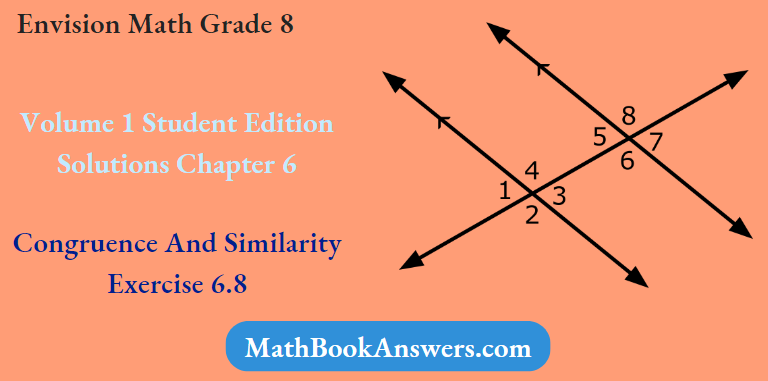
Envision Math Grade 8 Volume 1 Chapter 6.8 Solutions
Envision Math Grade 8 Volume 1 Student Edition Solutions Chapter 6 Congruence And Similarity Exercise 6.8 Page 345 Exercise 2 Answer
There are following properties and definitions should be satisfied to describe which angles have equal measures.
1. Alternate Interior Angles Theorem: When angles are formed inside of two parallel lines and intersect by traversal, are equal to their alternate pairs.

In the above figure, the interior angles:
∠A = ∠D, ∠B = ∠C
2. Alternate Exterior Angles Theorem: Two angles that lie on opposite sides of the transversal and are placed on two different lines, both either inside the two lines or outside, are called alternate angles.
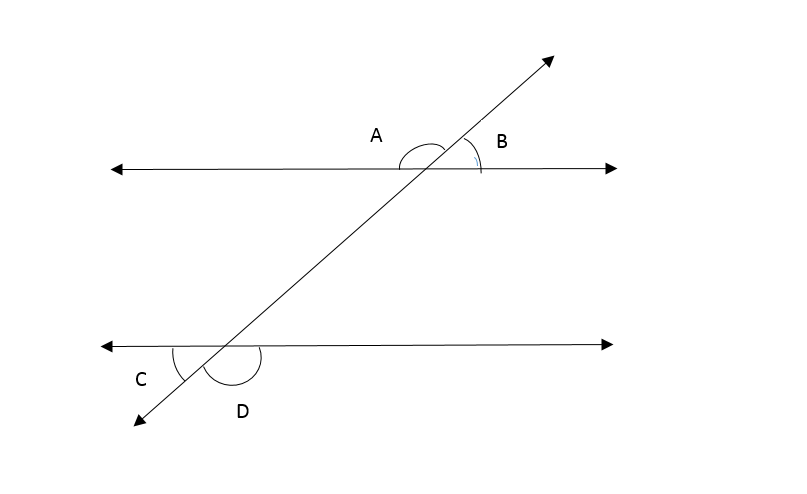
In the above figure, the exterior angles are:
∠A = ∠D, ∠B = ∠C
3. Corresponding Angles Theorem: Corresponding angles are formed in matching corners or corresponding corners with the transversal when two parallel lines are intersected by any other line.
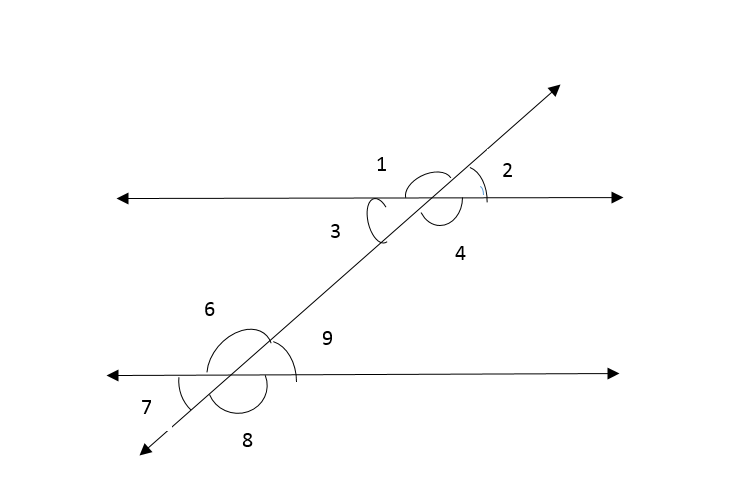
From the above figure, the corresponding angles are:
∠1 = ∠6, ∠2 = ∠9, ∠3 = ∠7, ∠4 = ∠8
4. Vertical Angles Congruence Theorem: The Vertical Angles are those angles when the opposite (vertical) angles of two intersecting lines are congruent.
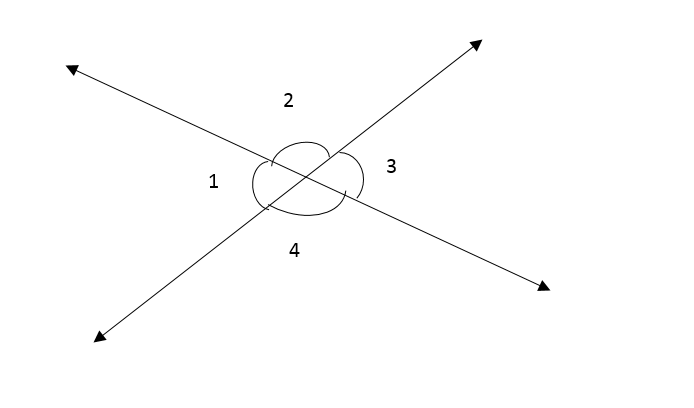
From the above figure, the vertical angles are:
∠1 = ∠3,∠2 = ∠4
There are the following properties to describe which angles have equal measures.
1. Alternate Interior Angles Theorem
2. Alternate Exterior Angles Theorem
3. Corresponding Angles Theorem
4. Vertical Angles Congruence Theorem
Congruence And Similarity Envision Math Exercise 6.8 Answers
Page 345 Focus On Math Practices Answer
There are following properties and definitions should be satisfied to describe which angles have equal measures.
1. Alternate Interior Angles Theorem: When angles are formed inside of two parallel lines and intersect by traversal, are alternate pairs of angles are equal.
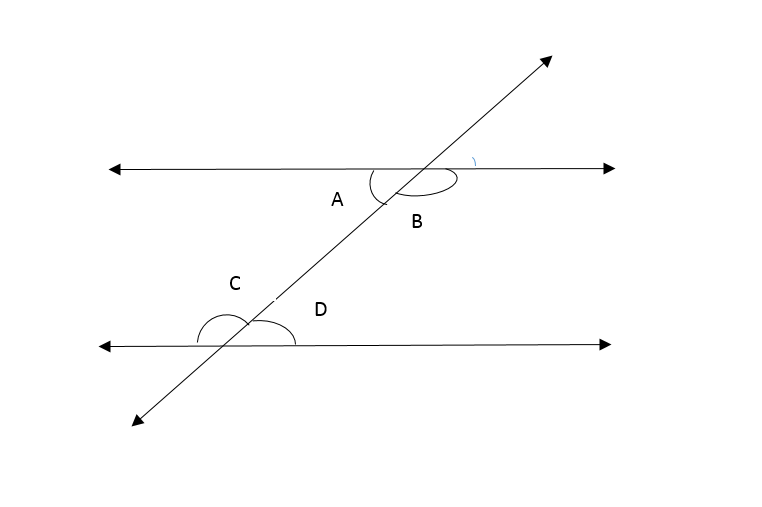
In the above figure, the interior angles:
∠A = ∠D,∠B = ∠C
2. Alternate Exterior Angles Theorem: Two angles that lie on opposite sides of the transversal and are placed on two different lines, both outside the two parallel lines are called alternate exterior angles. Alternate exterior angles are equal.
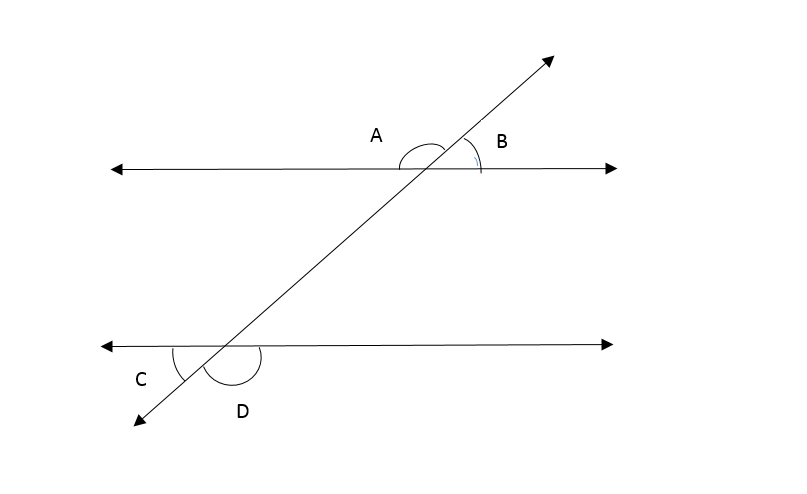
In the above figure, the exterior angles are:
∠A = ∠D,∠B = ∠C
3. Corresponding Angles Theorem: Corresponding angles are formed in matching corners or corresponding corners with the transversal when two parallel lines are intersected by any other line. Corresponding angles are equal.
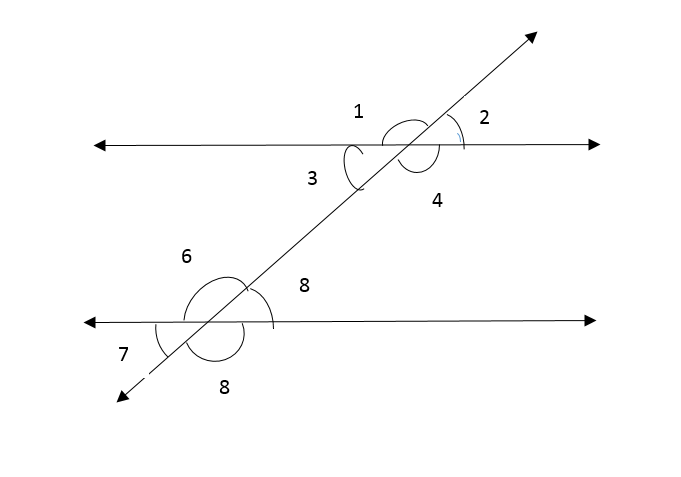
From the above figure, the corresponding angles are:
∠1 = ∠6,∠2 = ∠8,∠3 = ∠7,∠4 = ∠8
4. Vertical Angles Congruence Theorem: The Vertical Angles are the opposite (vertical) angles of two intersecting lines. They are always congruent.

From the above figure, the vertical angles are:
∠1 = ∠3,∠2 = ∠4
There are the following properties to describe which angles have equal measures.
1. Alternate Interior Angles Theorem
2. Alternate Exterior Angles Theorem
3. Corresponding Angles Theorem
4. Vertical Angles Congruence Theorem
Envision Math Grade 8 Chapter 6.8 Explained
Page 346 Essential Question Answer
When two parallel lines and a third line that crosses them as in the figure shown below, the crossing line is called a transversal.
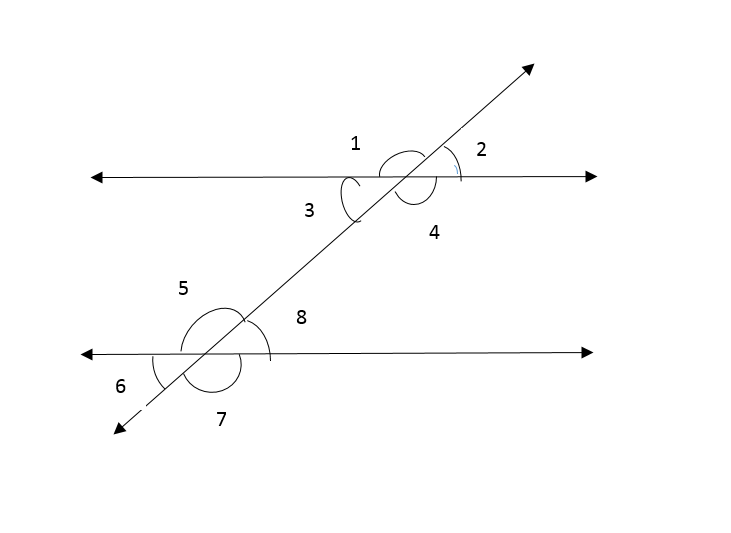
When a transversal intersects with two parallel lines, eight angles are produced.
The eight angles together form four pairs of corresponding angles.
The corresponding pairs are:
∠1 = ∠5,∠3 = ∠6,∠2 = ∠8,∠4 = ∠7
The alternate interior angles are formed inside of two parallel lines and intersect by traversal.
The alternate interior angles are:
∠3 = ∠8,∠4 = ∠5
Two angles that lie on opposite sides of the transversal and are placed on two different lines, both either inside the two lines or outside, are called alternate exterior angles.
The alternate exterior angles are:
∠1 = ∠7,∠2 = ∠6
All angles which are either exterior angles, interior angles, alternate angles, or corresponding angles are congruent.
When two parallel lines and a third line that crosses them, the crossing line is called a transversal.
All angles formed which are either exterior angles, interior angles, alternate angles, or corresponding angles, all of which are congruent.
Page 346 Try It Answer
The angles that are congruent to ∠8 are ∠4, ∠2, ∠6.
Because ∠8 and ∠4 are corresponding angles, angles that are on the same side of the transversal and the corresponding angles are congruent.
Therefore, ∠8 = ∠2 and ∠4 = ∠6 because these are alternate interior angles.
The angles that are supplementary to ∠8 are: ∠7,∠5,∠1,∠3
Those angles are the same side interior angles and those are:
m∠8 + m∠7 = 180
m∠8 + m∠5 = 180
m∠8 + m∠3 = 180
m∠8 + m∠1 = 180
These angles are supplementary.
The angles that are congruent to ∠8 are ∠4,∠2,∠6.
The angles that are supplementary to ∠8 are ∠7,∠5,∠1,∠3.
Page 346 Convince Me Answer
Given the figure in the question.
Explain why ∠4 and ∠5 are supplementary.
Use the definition of supplementary to find angles.
When two parallel lines are cut by a transversal, the interior angles on the same side of the transversal are called supplementary angles.
If the sum of the measures of the two angles is 180∘, then the angles are supplementary.
In the given figure, ∠4 and ∠5 are the interior angles on the same side of the transversal. Therefore the sum of the measures of the two angles ∠4 and ∠5 is 180∘ or ∠4 + ∠5 = 180∘.
Therefore ∠4 and ∠5 are supplementary.
Angles ∠4 and ∠5 are the interior angles on the same side of the transversal. Therefore the sum of the measures of the two angles is supplementary.
Solutions For Envision Math Grade 8 Exercise 6.8
Page 347 Try It Answer
Given the figure is as follows:

Find the value of ∠2,∠7.
By the use of theorems which are given in the tip to find the value of required angles.
In the given figure, angles 99∘ and ∠2 are the vertical angles.
Therefore, ∠2 = 99∘
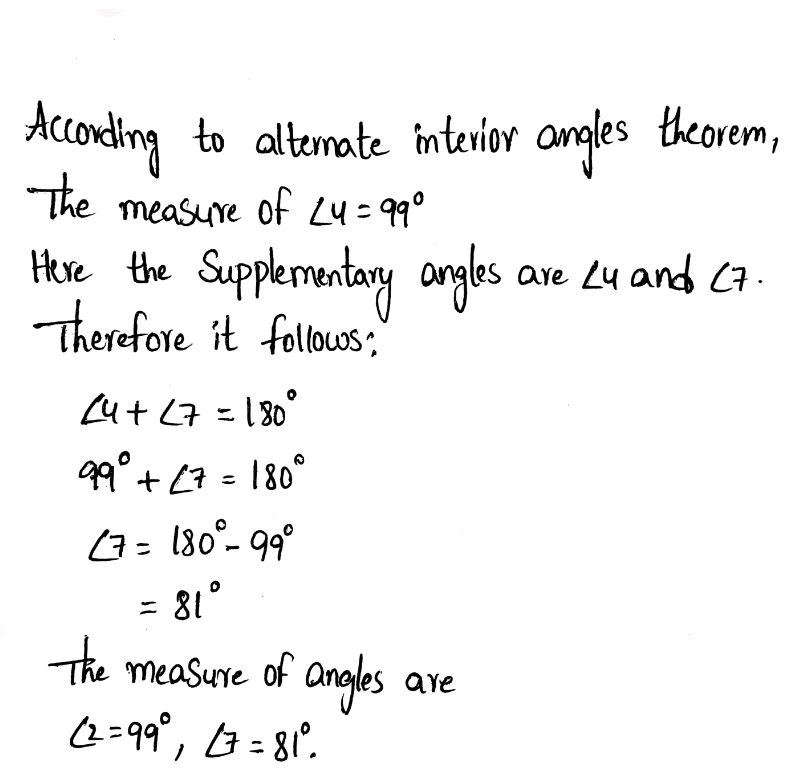
The measure of angles are
∠2 = 99∘, ∠7 = 81∘.
Page 347 Try It Answer
Given the figure in the question.
Find the value of x in the figure.
Use the definition of the corresponding angles theorem to find the value of x.
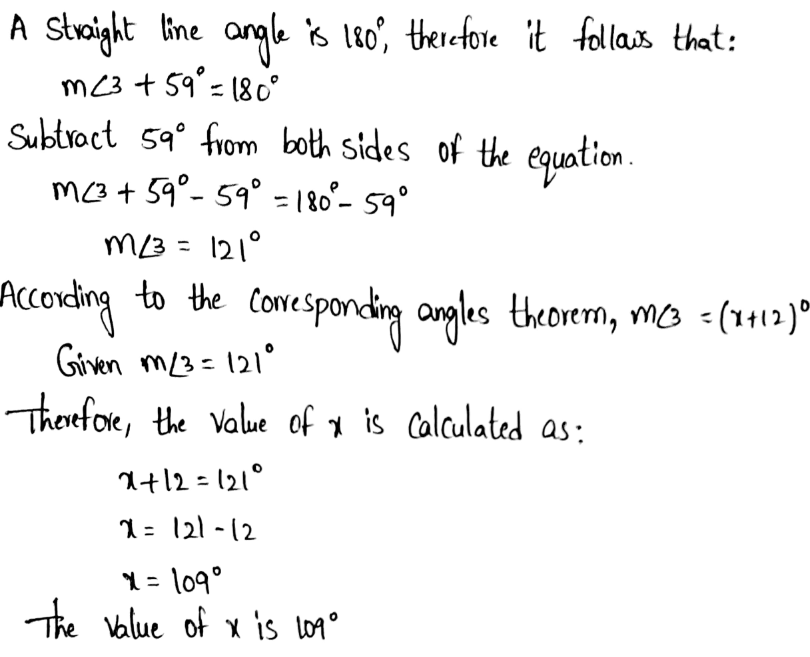
The value of x is 109∘.
Page 348 Try It Answer
Given the figure.
Find the value of x if a ∥ b.
Use the alternate interior angle theorem to find the value of x.
According to the alternate interior angle theorem, the angles 86∘ and (3x+17)∘ are alternate interior angles and it follows that the angles must be congruent.
Therefore, 86 = (3x+17)∘
Now the value of x is calculated as:
86 = 3x + 17
3x = 69
x = 23
The value of x is 23∘ if a ∥ b in the given figure.
Given the figure.
Find the value of x.
Use the consecutive interior angle theorem to find the value of x.
According to the consecutive interior angle theorem, the angles of measures 100∘ and (7x – 4)∘ are consecutive interior angles.
Therefore, 100 + (7x−4) = 180
Simplify the equation and find the value of x.
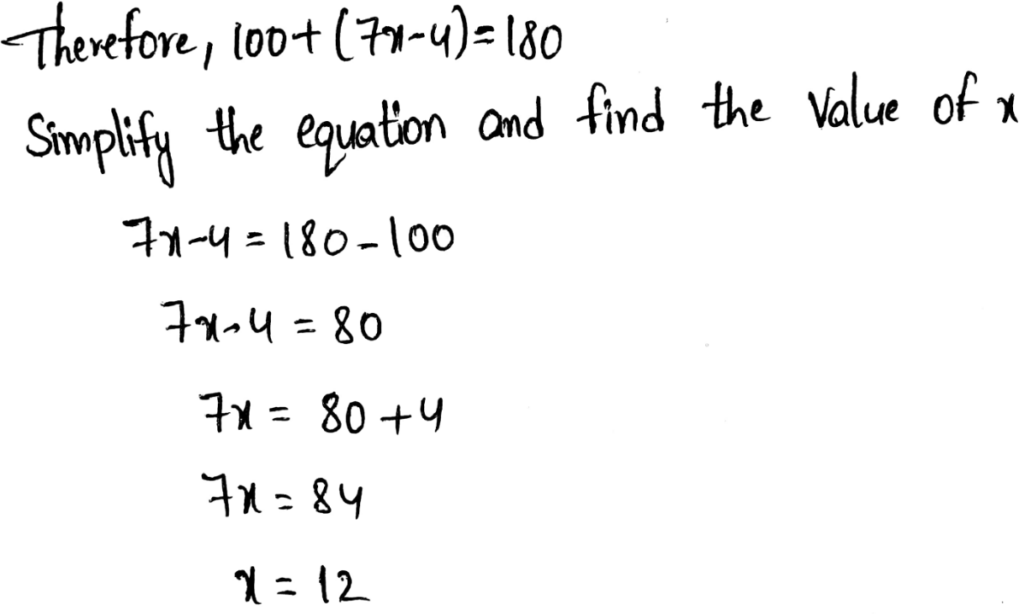
By the consecutive interior angle theorem, the value of x is 12.
Envision Math Grade 8 Volume 1 Chapter 6.8 Practice Problems
Envision Math Grade 8 Volume 1 Student Edition Solutions Chapter 6 Congruence And Similarity Exercise 6.8 Page 349 Exercise 2 Answer
When two parallel lines and a third line crosses them as in the figure shown below, the crossing line is called a transversal.
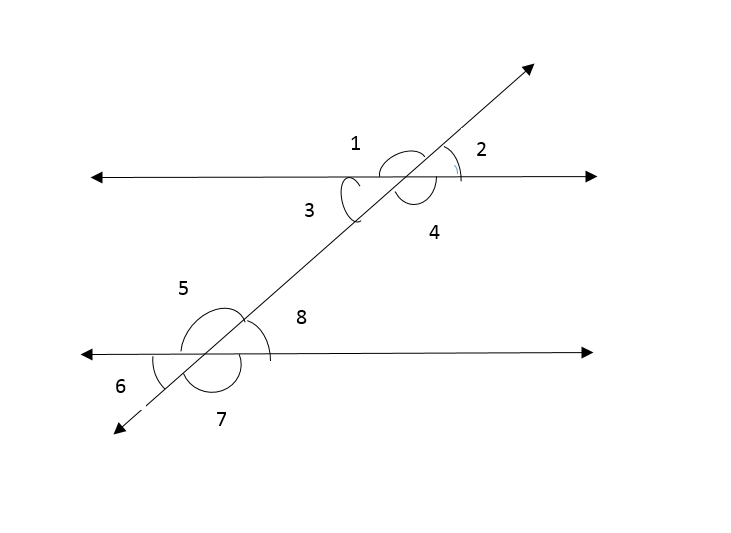
When a transversal intersects with two parallel lines, eight angles are produced.
The eight angles together form four pairs of corresponding angles.
The corresponding pairs are:
∠1 = ∠5,∠3 = ∠6,∠2 = ∠8,∠4 = ∠7
The alternate interior angles are formed inside of two parallel lines and intersect by traversal.
The alternate interior angles are:
∠3 = ∠8,∠4 = ∠5
Two angles that lie on opposite sides of the transversal and are placed on two different lines, both either inside the two lines or outside, are called alternate exterior angles.
The alternate exterior angles are:
∠1 = ∠7,∠2 = ∠6
All angles which are either exterior angles, interior angles, alternate angles, or corresponding angles are congruent.
When two parallel lines and a third line that crosses them, the crossing line is called a transversal.
All angles formed which are either exterior angles, interior angles, alternative angles, or corresponding angles all are congruent.
Envision Math Grade 8 Volume 1 Student Edition Solutions Chapter 6 Congruence And Similarity Exercise 6.8 Page 349 Exercise 3 Answer
Given:
Two parallel lines are cut by a transversal.
To find:
number of angles made by the transversal and measure of those angles.
For finding number of angles and their measures we need to assume a transversal between two parallel lines anf then with the help of tip we have to find the measures of all angles.
When two parallel lines are cut by a transversal, 8 angles are formed as shown:
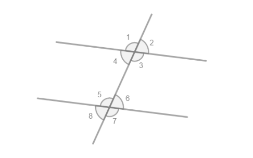
∠1 and ∠3are vertical angles, it follows:
∠1 ≅ ∠3
∠1,∠5 and ∠3,∠7 are corresponding angles.
and according to the corresponding angles theorem:
∠1 ≅ ∠5 ; ∠3 ≅ ∠7
Since, ∠1 ≅ ∠3, it can be concluded that:
∠1 ≅ ∠5 ≅ ∠3 ≅ ∠7
from the definition of congruent angles:
∠1 = ∠5 = ∠3 = ∠7
Similarly, it can be proved that:
∠2 = ∠4 = ∠6 = ∠8
When two parallel lines are cut by a transversal, 8 angles are formed.
There are two angle measures.
Envision Math 8th Grade Congruence And Similarity Topic 6.8 Key Concepts
Page 349 Exercise 4 Answer
Given: angle measures of some angles.
To find:
How to tell whether two lines are parallel with the help of angle measures.
Intersect them with a transversal, if the created corresponding angles are equal then they are parallel according to the corresponding angles theorem.
Intersect them with a transversal, if the created corresponding angles are equal then they are parallel according to the corresponding angles theorem.
Page 349 Exercise 6 Answer
Given:
m∠4 = 70
To find:
m ∠ 6
We need to refer to the tip for finding the above angle, alternate-interior angles property is also useful.
Since∠4 and ∠6 are alternate-Interior angles, it follows that:
m∠4 = m∠6
Substitute m∠4 = 70∘ into the equation:
70∘ = m∠6
Therefore, m∠6 = 70∘.
The value of m∠6 = 70∘.
Page 349 Exercise 8 Answer
Given:
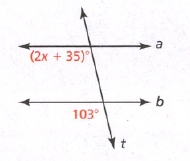
To find:
Value of x
Use the corresponding angles property to find the value of x.
Notice that since a is parallel to b and t is their transversal line, the angles (2x+35)∘ and 103∘ are corresponding angles.
Thus, the two angles are congruent, and their measures are equal.
2x + 35 = 103
Solve the equation for x:

The value of x must be equal to 34∘
Page 350 Exercise 9 Answer
Given:
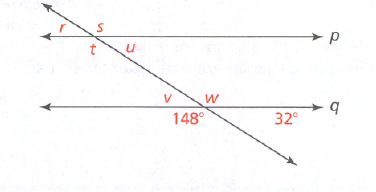
To find:
value of u
In order to find the value of u we have to use the corresponding angle property.
Notice that u and 32∘ are corresponding angles.
Using the corresponding angles theorem, it follows that:
u = 32
The value of u is 32∘
Envision Math Grade 8 Volume 1 Student Edition Solutions Chapter 6 Congruence And Similarity Exercise 6.8 Page 350 Exercise 10 Answer
Given:
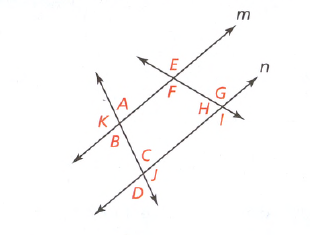
To prove:
∠K and ∠B are corresponding angles.
In order to prove that the above angles are corresponding angles refer to the tip mentioned .
Although both ∠K and ∠B lie on the same side of the transversal, they do not have the same relative positions with respect to the parallel lines.
So they do not satisfy the second condition for the corresponding angles.
Therefore, ∠K and ∠B are not corresponding angles.
Hence, ∠K and ∠B are not corresponding angles.
Envision Math Grade 8 Chapter 6.8 Lesson Overview
Page 350 Exercise 11 Answer
Given:
A and B are parallel to each other.
∠6 = 155
To find: measure of ∠4
In order to find the value of the above, we have to use consecutive interior angle theorem.
Avenue C is the transversal to parallel avenue A and B
∠6 = 155

From the consecutive interior angle theorem, it follows:
∠6 + ∠4 = 180
Replace ∠6 = 155∘:
155∘ + ∠4 = 180∘
Subtract 155∘ from both side:
155∘ + ∠4 − 155∘ = 180∘ − 155∘
Cancel 155∘ in left side of equation:
∠4 = 180∘ − 155∘
Calculate value of ∠4 :
180∘ − 155∘
= 25∘
The measure of ∠4 is 25∘
Envision Math Grade 8 Volume 1 Student Edition Solutions Chapter 6 Congruence And Similarity Exercise 6.8 Page 350 Exercise 12 Answer
Given: measure of ∠6 = 53
To find: measure of ∠12
In order to find the value of the above, we have to use alternate interior angle theorem and supplementary angles theorem.
Observe that ∠6 and ∠11 are alternate interior angles, therefore:
m∠6 = m∠11
∠11 and ∠12 are supplementary angles, therefore:
m∠12 = 180 − m∠11
Substitute m∠11 = m∠6 into the equation:
m∠12 = 180 − m∠6
Substitute m∠6 = 53 into the equation:
m∠12 = 180 − 53
m∠12 = 127
The measure of m∠12 = 127∘
Page 351 Exercise 14 Answer
Given:
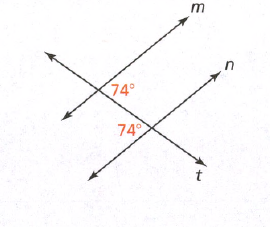
To prove:
m ∥ n
In order to prove the above we can use alternate interior angles converse theorem.
Notice that the two angles of measure 74° are alternate interior angles.
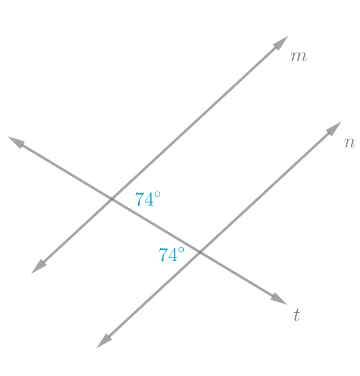
Using the alternate interior angles converse, it follows that: m ∥ n
Using the alternate interior angles converse, it follows that:
m ∥ n
Page 351 Exercise 15 Answer
Given:
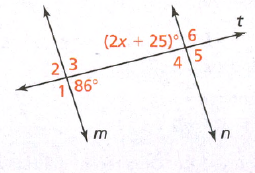
To find :
Value of x and each missing angle measure.
In order to find the value of x we can refer to alternate interior angles theorem and for the other angles, we can refer to the tip mentioned.
Line t intersects two parallel lines n and m, so it’s a transversal.
Angles ∠86° and (2x+25) are alternate interior angles.
From the alternate interior angles theorem, it follows:
2x + 25 = 86
2x = 61
x = 30.5
Angles (2x + 25) angle and ∠3 are same side interior angles.
By the same side interior angles theorem. since (2x+25) = 86 it follows:
m∠3 + 86 = 180
m∠3 = 94
Angles ∠3 and ∠1 are vertical angles.
Therefore, by the vertical angles congruence theorem:
m∠1 = m∠3
Substitute m∠3 = 94 into the equality:
m∠1 = 94
Angles ∠2 and 86 angles are vertical angles.
Therefore, by the vertical angles congruence theorem:
m∠2 = 86
Angles(2x + 25) and ∠6 are supplementary angles
Therefore, the sum of their measures is:
(2x+25) + m∠6 = 180
86 + m∠6 = 180
m∠6 = 94
Angles ∠4 and ∠6 are vertical angles.
Therefore, by the vertical angles congruence theorem:
m∠4 = m∠6
94 = m∠4
m∠4 = 94
Angles ∠4 and ∠5 are supplementary angles.
Therefore, the sum of their measures is:
m∠4 + m∠5 = 180
94 + m∠5 = 180
m∠5 = 86
The value of x = 30.5
The measures of other missing angles are as follows:
m∠1 = 94°,m∠2 = 86°
m∠3 = 94°,m∠4 = 94°
m∠5 = 86°,m∠6 = 94°
Page 351 Exercise 16 Answer
Given:
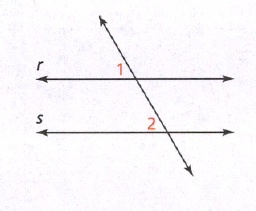
To find:
Value of x
if m∠1 = (63 − x)
m∠2 = (72 − 2x)
In order to find the above we have to refer the tip mentioned and use the theorems accordingly.
Since the labeled angles are corresponding angles, it follows that:
m∠1 = m∠2
Substitute ∠1 = 63 − x and ∠2 = 72 − 2x into the equation:
63 − x = 72 − 2x
Solve for the value of x:
63 − x = 72 − 2x
x = 72 − 63
x = 9
Therefore, the value of x = 9
The value of x is 9
Given:
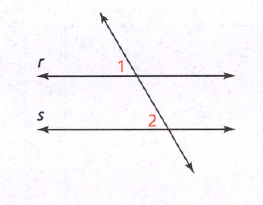
To find:
m∠1 and m∠2
In order to find the above we have to refer to the theorems mentioned in tip
Since line r and s are parallel, angles ∠1 and ∠2 are congruent according to the Corresponding Angle Theorem. It follows that:
∠1 ≅ ∠2
Since ∠1 and ∠2 are congruent angles, their measures are equal. It follows that:
m∠1 = m∠2
Substitute m∠1 = (63 – x)∘ and m∠2 = (72 – 2x)∘ into the equation:
(63 – x)∘ = (72 – 2x)∘
Solve for x:
63 − x = 72 − 2x
x = 9
m∠1 = (63 – x)∘
Substitute x = 9 into the equation:
m∠1 = (63 – 9)∘
Subtract the numbers
m∠1 = 54∘
m∠2 = (72 – 2x)∘
Substitute x = 9 into the equation:
m∠2 = (72 – 2(9))∘
m∠2 = (72 – 18)∘
m∠2 = 54
Therefore, both angles have the same measurement since they are corresponding angles.
The measures of the angles are:
m∠1 = m∠2 = 54∘
They are equal because they are corresponding angles.
Envision Math Grade 8 Topic 6.8 Transformations Practice
Envision Math Grade 8 Volume 1 Student Edition Solutions Chapter 6 Congruence And Similarity Exercise 6.8 Page 352 Exercise 17 Answer
Given:
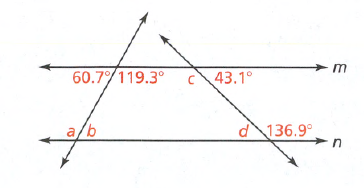
To find:
∠b and ∠d
In order to find these angles we have to use supplementary angles theorem and also refer to the tip.
the Use the property of supplementary angles:
∠d + ∠136.9∘ = 180∘
∠d = 180∘ − 136.9
∠d = 43.1
As m is parallel to n. so use property of alternate interior angles:
∠b = 60.7∘
Hence, measurement of ∠b = 60.7∘ and measurement of ∠d = 43.1∘
Page 352 Exercise 18 Answer
Given:
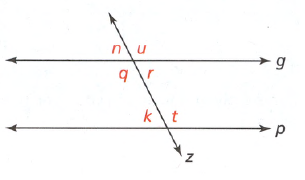
To find:
Angles which are alternate interior angles.
In order to find the alternate interior angles refer to the tip mentioned.
The alternate interior angles are the angles formed when a transversal intersects two parallel lines, and lie on the inner side of the two parallel lines, on opposite sides of the transversal.
From this definition, we can easily identify the alternate interior angles by looking at the figure.
∠q and ∠t, ∠r and ∠k are alternate interior angles.
The alternate interior angles are ∠q and ∠t, ∠r and ∠k.
Page 352 Exercise 19 Answer
Given:
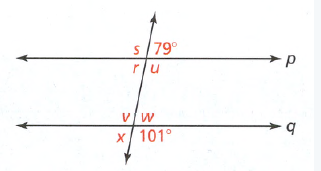
To find:
Value of w
To find the value of the above we have to use the theorem of supplementary angles.
Since the angles w and the angle of the measure of 101∘ are adjacent angles that form a straight angle, they are supplementary angles and it follows:
w + 101 = 180
Solve the equation for w:
w + 101 = 180
w = 79
The value of w is 79
Given:
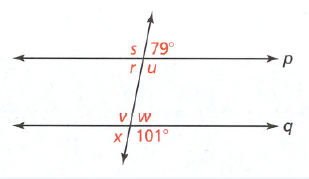
To find:
Mistake of Jacob.
in order to find the error in jacob’s calculation we have to use the theorems mentioned in tip.
The boy made a mistake by determining the angle of w, because from the Vertical Angles Congruence Theorem, the angle with measure of 101° is v.
Also, notice that w and 101∘ form a linear pair.
Since w and 101∘ are supplementary angles, therefore the value of w should be:
w = 180∘ − 101∘ = 79∘
The boy might think that w is the vertical angle of the angle that measures 101∘.
The boy might think that the angles that form linear pairs are equal.
